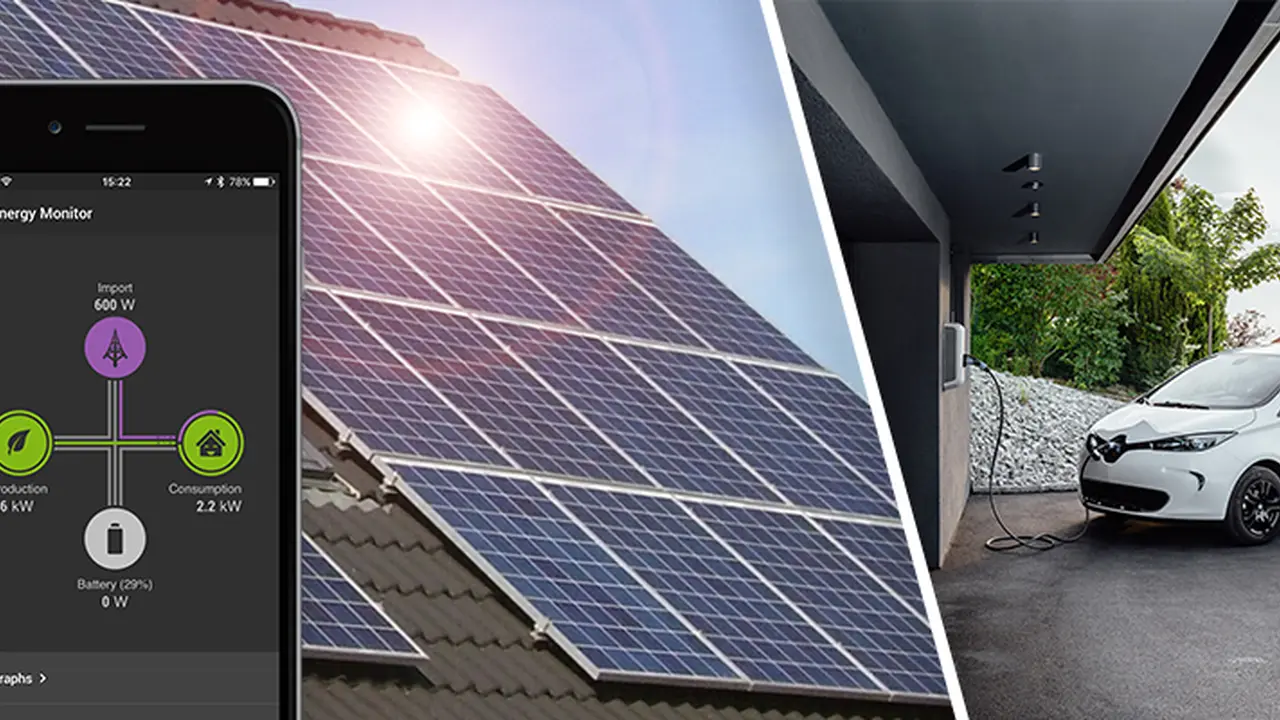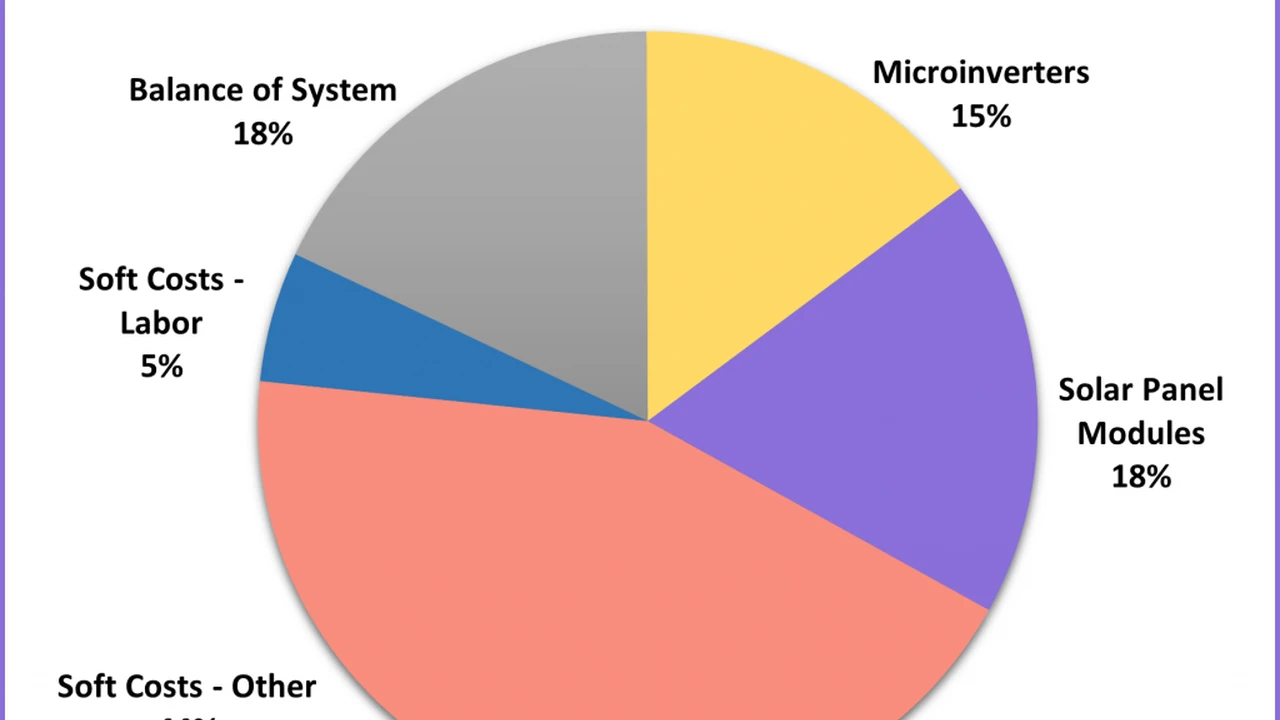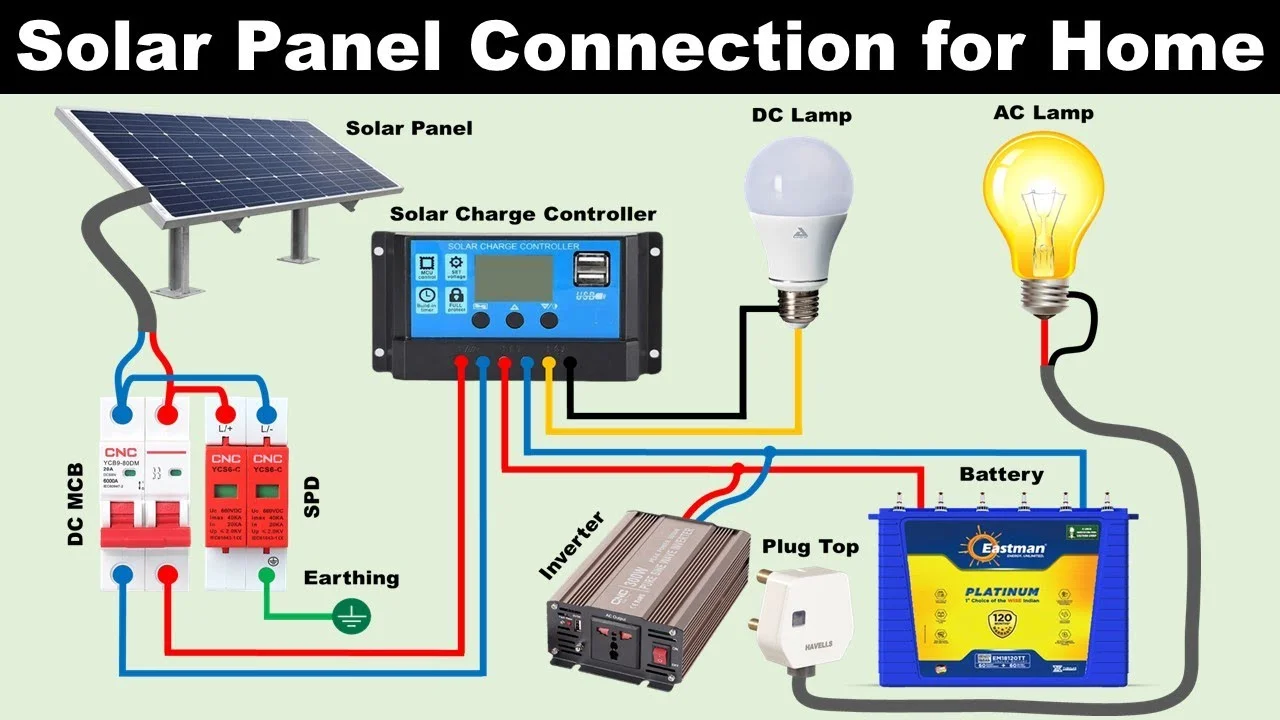Solar Panel and Home Automation: Integrating Smart Technology

Understanding the Synergy Solar Panels and Smart Home Tech
Hey folks! Ever wondered how your solar panels can do more than just generate electricity? Well, buckle up because we're diving deep into the world of integrating solar panel systems with your smart home technology. This isn't just about saving money on your electricity bill; it's about creating a seamless, energy-efficient, and downright futuristic living experience.
Imagine this: your solar panels are soaking up the sun's rays, powering your home, and simultaneously communicating with your smart thermostat to adjust the temperature based on energy production. Or, your smart lighting system dims automatically when the solar panels are generating peak power, maximizing your self-consumption and minimizing reliance on the grid. That's the power of solar panel and home automation integration!
Key Benefits of Combining Solar Power and Smart Home Systems Energy Efficiency
Let's talk benefits, shall we? The most obvious one is energy efficiency. By connecting your solar panels to your smart home, you can optimize energy usage in real-time. Your smart devices can react to the amount of solar energy being produced, ensuring you're using the free, clean energy first. Think of it as your home becoming a mini-grid, intelligently managing its power consumption.
For example, during peak sunlight hours, your smart water heater could preheat water, or your electric vehicle charger could kick into high gear. And when the sun goes down, your smart home can automatically switch to grid power while minimizing unnecessary energy waste.
Cost Savings with Smart Solar Integration
Beyond energy efficiency, you'll see some serious cost savings. By maximizing your self-consumption of solar energy, you'll reduce your reliance on the utility grid, leading to lower electricity bills. Plus, some utility companies offer incentives for homes with smart energy management systems, further boosting your savings.
Think about it: no more guessing when to run your appliances to avoid peak-hour charges. Your smart home will handle it all, automatically shifting energy usage to times when solar production is high and electricity rates are low.
Increased Home Value Through Smart Solar Upgrades
And here's a bonus: integrating solar panels and smart home technology can increase your home's value. Smart homes are becoming increasingly desirable, and adding a solar component makes your home even more attractive to potential buyers. It's a win-win!
A home that is energy-efficient, technologically advanced, and environmentally friendly is a huge selling point in today's market. It shows that you've invested in the future and are committed to sustainability.
Popular Smart Home Devices for Solar Panel Integration Smart Thermostats
Okay, let's get into the nitty-gritty of specific devices. Smart thermostats are a must-have for any smart home, and they work wonders with solar panels. They can learn your heating and cooling preferences and adjust the temperature automatically to maximize energy savings.
Product Recommendation:
- Nest Learning Thermostat: This thermostat learns your habits and adjusts the temperature accordingly. It also offers remote control via your smartphone and integrates seamlessly with other Nest devices. Price: around $250.
- Ecobee SmartThermostat with Voice Control: Similar to Nest, Ecobee offers intelligent temperature control and voice assistant integration. It also comes with a remote sensor to monitor temperature in different rooms. Price: around $200.
Comparison: Nest is known for its sleek design and user-friendly interface, while Ecobee offers more advanced features like remote sensors and better compatibility with other smart home platforms.
Usage Scenario: Imagine your solar panels are generating lots of power in the afternoon. Your smart thermostat can automatically pre-cool your home, reducing the need for air conditioning later in the evening when solar production is lower.
Smart Lighting Systems
Smart lighting systems are another great way to integrate solar panels with your smart home. They allow you to control your lights remotely, set schedules, and even dim the lights automatically based on solar energy production.
Product Recommendation:
- Philips Hue: A popular smart lighting system with a wide range of bulbs, lamps, and accessories. It offers customizable lighting scenes and integrates with other smart home platforms. Price: Starter kits range from $70 to $200.
- LIFX: Another great option with vibrant colors and easy setup. LIFX bulbs connect directly to your Wi-Fi, so you don't need a hub. Price: Individual bulbs range from $30 to $80.
Comparison: Philips Hue requires a hub, but it offers a more established ecosystem and wider compatibility. LIFX is easier to set up and offers brighter colors, but it may not be as compatible with all smart home platforms.
Usage Scenario: During peak solar production, your smart lights can automatically dim to conserve energy. Or, you can set up a lighting scene that uses only the energy generated by your solar panels.
Smart Plugs and Outlets
Smart plugs and outlets are a simple yet effective way to control your appliances and electronics remotely. You can use them to turn devices on or off, set schedules, and monitor energy usage.
Product Recommendation:
- TP-Link Kasa Smart Plug: A budget-friendly option that offers remote control and energy monitoring. Price: around $15 per plug.
- Wemo Mini Smart Plug: Another popular option with a compact design and easy setup. Price: around $20 per plug.
Comparison: Both TP-Link Kasa and Wemo Mini are reliable and affordable. TP-Link Kasa is slightly cheaper, while Wemo Mini has a more compact design.
Usage Scenario: You can use smart plugs to automatically turn off appliances when your solar panels are not producing enough energy, or to schedule appliances to run during peak solar production hours.
Smart Inverters and Energy Monitors
Let's talk about the brains of the operation: smart inverters and energy monitors. These devices track your solar panel production and energy consumption in real-time, providing valuable data that you can use to optimize your energy usage.
Product Recommendation:
- Enphase Energy: Enphase offers microinverters that optimize energy production at the panel level and provide detailed monitoring data. Price: Varies depending on the system size.
- SolarEdge: SolarEdge offers power optimizers that maximize energy production and provide advanced safety features. Price: Varies depending on the system size.
Comparison: Enphase microinverters are installed on each individual solar panel, while SolarEdge power optimizers are installed on each panel and connected to a central inverter. Enphase offers more granular monitoring, while SolarEdge may be more cost-effective for larger systems.
Usage Scenario: With a smart inverter, you can see exactly how much energy your solar panels are producing and how much energy your home is consuming. This allows you to make informed decisions about your energy usage and maximize your self-consumption of solar energy.
Installation Considerations for Solar and Smart Home Integration
Alright, before you start ripping out your walls and wiring up everything, let's talk about installation considerations. Integrating solar panels and smart home technology can be complex, so it's important to plan carefully and work with qualified professionals.
First, make sure your solar panel system is compatible with your smart home devices. Some devices may require specific inverters or energy monitors. Second, consider the wiring and networking requirements. You may need to run new wires or upgrade your Wi-Fi network to support all of your smart devices.
Finally, don't be afraid to ask for help. A qualified solar installer or smart home integrator can help you design and install a system that meets your specific needs and budget.
Future Trends in Solar Panel and Smart Home Technology
The future is bright (pun intended!) for solar panel and smart home technology integration. We're seeing advancements in battery storage, artificial intelligence, and the Internet of Things (IoT) that are making homes even more energy-efficient and intelligent.
Imagine a future where your home automatically adjusts its energy usage based on weather forecasts, electricity prices, and your personal preferences. Or a future where your home can communicate with the grid to provide demand response services, helping to stabilize the electricity supply. The possibilities are endless!
DIY vs Professional Installation for Smart Solar Systems
So, you're thinking of diving into the world of smart solar? Great! But before you grab your tools, let's talk about the DIY versus professional installation debate. While some aspects of smart home integration are definitely DIY-friendly, others are best left to the pros, especially when dealing with electricity and your solar panel system.
DIY Perks:
- Cost Savings: Obviously, doing it yourself can save you a bundle on labor costs.
- Control: You get to choose the products and do things exactly how you want.
- Satisfaction: There's a certain pride that comes with knowing you built something yourself.
Professional Installation Perks:
- Expertise: Pros have the knowledge and experience to ensure everything is installed correctly and safely.
- Warranty: Professional installations often come with warranties, protecting you from potential issues.
- Time Savings: Let's be honest, installing a whole smart solar system can be time-consuming.
Which Parts Can You DIY?
- Smart Plugs and Outlets: These are generally plug-and-play and easy to install yourself.
- Smart Lighting: Swapping out regular bulbs for smart bulbs is a breeze.
- Smart Thermostats (Sometimes): If you're just replacing an existing thermostat, it's usually a straightforward process, but always double-check the wiring.
Which Parts Should You Leave to the Pros?
- Solar Panel Installation: This is a no-brainer. Working with high-voltage electricity is dangerous and requires specialized knowledge.
- Smart Inverter Installation: Similar to solar panels, inverters handle significant amounts of power and should be installed by a certified electrician.
- Complex Wiring: If your smart home integration requires significant rewiring, it's best to call in the experts.
The Bottom Line: Evaluate your skills and comfort level. If you're unsure about anything, err on the side of caution and hire a professional. Your safety and the proper functioning of your system are worth the investment.
Troubleshooting Common Issues with Smart Solar Setups
Okay, so you've got your smart solar system up and running. Awesome! But what happens when things go wrong? Don't panic! Here are some common issues and how to troubleshoot them:
- Issue: Smart Devices Not Connecting to Wi-Fi
- Solution: Check your Wi-Fi router. Is it working properly? Are your smart devices within range? Try restarting your router and devices. If that doesn't work, you may need to upgrade your Wi-Fi network or add a Wi-Fi extender.
- Issue: Solar Panel Production Not Showing Up in the App
- Solution: Check your inverter. Is it communicating with the monitoring system? Make sure all connections are secure. If the problem persists, contact your solar installer.
- Issue: Smart Thermostat Not Responding to Solar Production
- Solution: Check the integration settings. Is your smart thermostat properly connected to your solar monitoring system? Make sure the settings are configured to adjust the temperature based on solar production.
- Issue: Higher Than Expected Energy Bills Despite Solar Panels
- Solution: Monitor your energy usage. Are you using more energy than you thought? Make sure your smart devices are properly configured to conserve energy. You may also need to adjust your energy habits.
- Issue: Unexpected Power Outages
- Solution: Check your battery storage (if you have one). Is it functioning properly? Make sure your system is properly configured to switch to battery power during outages. If the problem persists, contact your solar installer.
General Tips:
- Read the Manuals: Seriously, they're there for a reason.
- Check the Connections: Make sure all cables and wires are securely connected.
- Restart Everything: Sometimes a simple reboot can fix a lot of problems.
- Contact Support: Don't be afraid to reach out to the manufacturer or installer for help.
Maximizing Your Return on Investment (ROI) with Smart Solar
Alright, let's talk money! Investing in a smart solar system is a big decision, so you want to make sure you're getting the most bang for your buck. Here's how to maximize your ROI:
- Right-Sizing Your Solar System: Don't go too big or too small. Calculate your energy needs and choose a solar system that meets those needs without excessive overproduction.
- Optimizing Self-Consumption: Use your smart home devices to consume as much of your solar energy as possible. Run appliances during peak production hours and store excess energy in batteries.
- Taking Advantage of Incentives and Rebates: Research and apply for all available federal, state, and local incentives and rebates. This can significantly reduce the upfront cost of your system.
- Monitoring Your System Performance: Regularly monitor your solar panel production and energy consumption to identify any issues and optimize performance.
- Maintaining Your System: Keep your solar panels clean and free of debris. Schedule regular maintenance checks to ensure everything is functioning properly.
- Considering Battery Storage: Battery storage can increase your self-consumption and provide backup power during outages, further increasing your ROI.
- Reducing Overall Energy Consumption: The less energy you use, the more you'll save with solar. Implement energy-efficient practices throughout your home.
- Choosing the Right Financing Option: Explore different financing options and choose the one that best suits your financial situation.
Example Calculation: Let's say you invest $20,000 in a smart solar system that saves you $2,000 per year on your electricity bill. With a 30% federal tax credit, your upfront cost is reduced to $14,000. In 7 years, your system will pay for itself, and after that, you'll be saving money every year for the life of the system.
Security Considerations for Connected Solar Systems
With all this smart technology, it's important to consider security. Your solar system and smart home devices are connected to the internet, which means they're vulnerable to hacking and cyberattacks. Here's what you need to know:
- Secure Your Wi-Fi Network: Use a strong password and enable WPA3 encryption.
- Update Firmware Regularly: Keep your smart devices updated with the latest firmware to patch security vulnerabilities.
- Use Strong Passwords: Don't use the same password for all your devices.
- Enable Two-Factor Authentication: This adds an extra layer of security to your accounts.
- Be Aware of Phishing Scams: Don't click on suspicious links or open attachments from unknown senders.
- Monitor Your Network Traffic: Keep an eye on your network traffic for any unusual activity.
- Use a Firewall: A firewall can help protect your network from unauthorized access.
- Consider a Separate Network for Smart Devices: This can isolate your smart devices from your main network and protect your sensitive data.
- Research the Security Features of Your Devices: Choose devices from reputable manufacturers with strong security features.
Future Proofing Your Smart Solar Investment
Technology changes quickly, so it's important to future-proof your smart solar investment. Here's how:
- Choose Scalable Systems: Select smart home devices and solar components that can be easily upgraded or expanded in the future.
- Embrace Open Standards: Opt for devices that support open standards like Matter, which allows for interoperability between different brands and platforms.
- Consider Battery Storage with Expandable Capacity: As your energy needs grow, you may want to add more battery capacity.
- Stay Informed About New Technologies: Keep up with the latest advancements in solar and smart home technology.
- Choose a Reputable Installer: A reputable installer will be able to advise you on future-proofing your system.
- Plan for Maintenance and Repairs: Factor in the cost of future maintenance and repairs when budgeting for your system.
- Consider the Lifespan of Your Components: Solar panels typically last 25-30 years, while inverters and batteries have shorter lifespans.
- Think About Resale Value: A smart solar system can increase the resale value of your home.
:max_bytes(150000):strip_icc()/277019-baked-pork-chops-with-cream-of-mushroom-soup-DDMFS-beauty-4x3-BG-7505-5762b731cf30447d9cbbbbbf387beafa.jpg)






